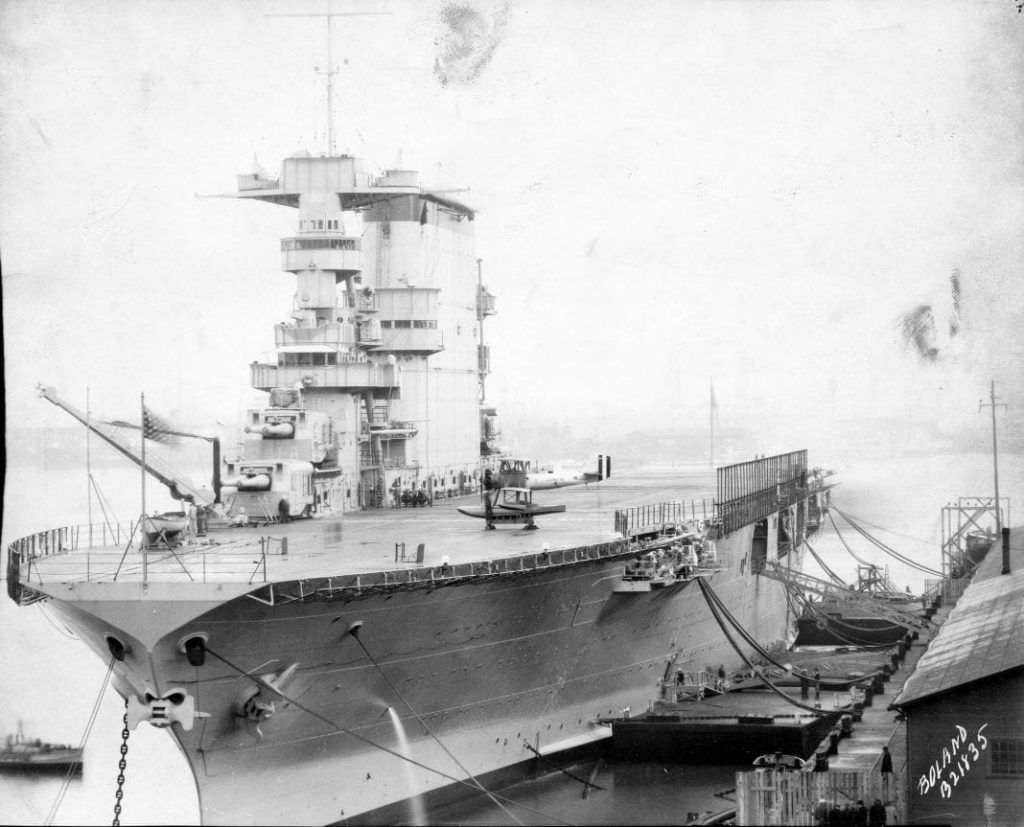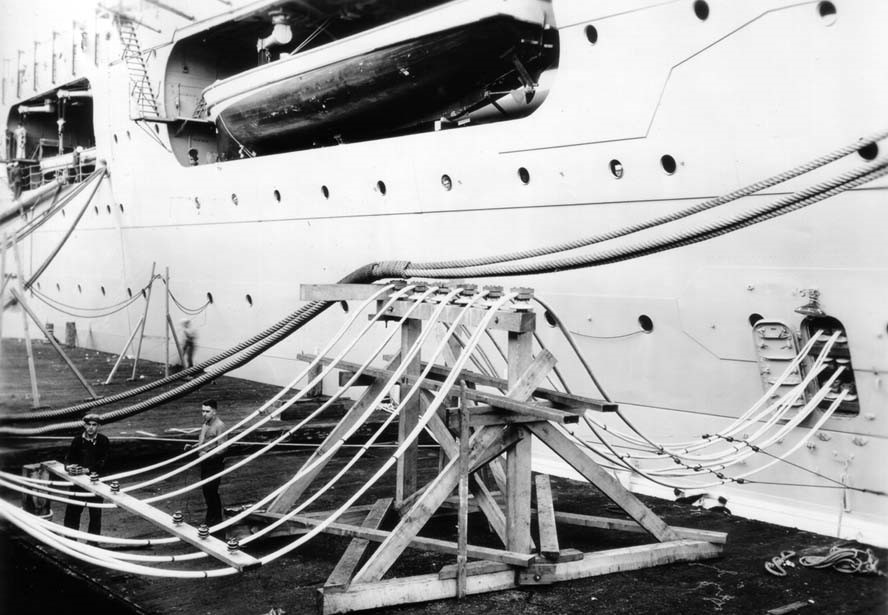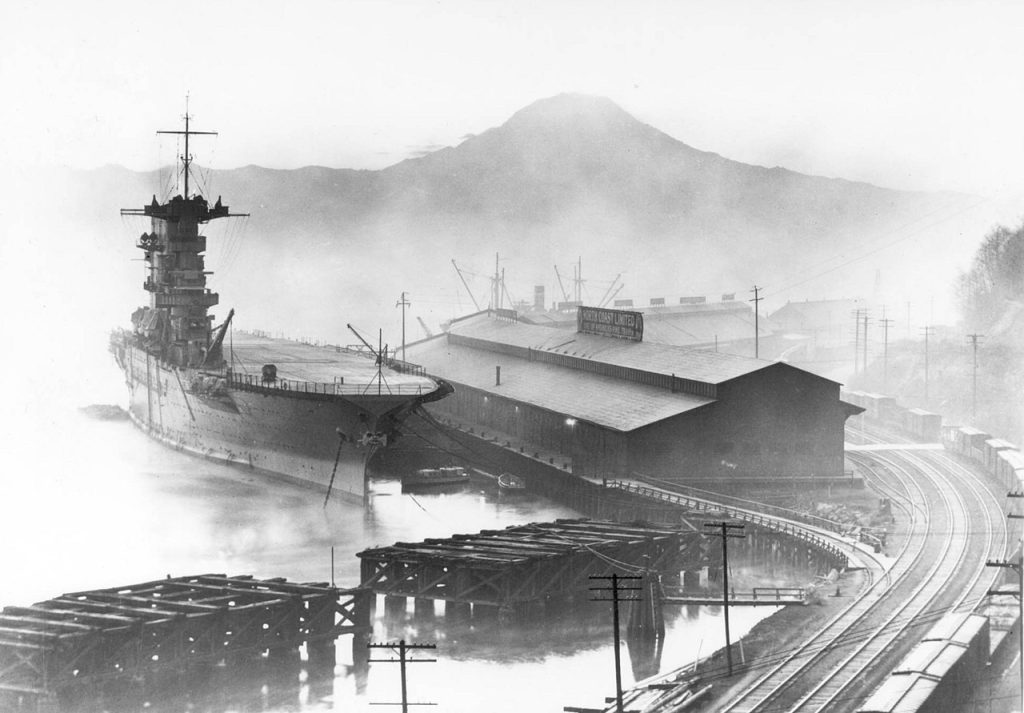The USS Lexington (CV-2), also known as “Lady Lex,” had a distinguished service history that reflected the growing importance of naval aviation in warfare.
Commissioned in 1927, she was among the first operational aircraft carriers in the United States Navy, and her service life spanned crucial years leading up to and into the early years of World War II.
In 1929, the USS Lexington was repurposed to provide emergency electrical power to Tacoma, Washington, during a severe drought that crippled the city’s hydroelectric power sources.
For about a month, the Lexington, using its turbo-electric propulsion system, generated electricity for the city.
Design of the USS Lexington
The USS Lexington (CV-2), commissioned in 1927, was one of the first operational aircraft carriers in the United States Navy and marked a significant point in naval architecture and carrier design.
With a length of approximately 888 feet and a beam of 105.5 feet, the Lexington was a formidable presence on the sea. Its standard displacement was around 36,000 tons, ballooning to over 47,000 tons when fully loaded, showcasing its massive scale.
One of its most distinctive features was the adoption of turbo-electric propulsion, a novel choice that endowed the carrier with a top speed of around 34 knots. This system involved four Westinghouse turbo generators powering electric motors connected to the propeller shafts.
 USS Lexington before her launch, October 1925.
USS Lexington before her launch, October 1925.
Armament-wise, the Lexington initially boasted 8 × 8-inch guns and 12 × 5-inch anti-aircraft guns, reflecting the heavy armament typical of earlier carrier designs. However, as the carrier’s role evolved to prioritize air power, some of this armament was reduced to accommodate more aircraft.
Speaking of aircraft, the Lexington could carry around 78 planes, including fighters, bombers, and reconnaissance aircraft. The design featured a full-length flight deck and two below-deck hangars, with elevators facilitating the movement of aircraft between decks. Initially, the carrier also had a “fly-off” deck at the bow, which was later removed as aircraft and catapult technologies advanced.
The operational role of the Lexington was groundbreaking. As one of the inaugural aircraft carriers, it significantly influenced the development of carrier tactics and the concept of naval air power.
Its participation in various exercises demonstrated the strategic value of such ships as mobile air bases, capable of projecting power far beyond the range of traditional battleships.
Background of the Tacoma Power Crisis
The late 1920s in the Pacific Northwest of the United States was a period characterized by significant industrial expansion and urban growth.
Cities like Tacoma, Washington, were thriving centers of commerce and industry, their economies bolstered by an abundance of natural resources and a strategic location.
Tacoma, in particular, had developed into a significant hub for lumber and paper production, owing to its proximity to vast forest resources and its advantageous coastal location.
This period of growth was accompanied by an escalating demand for electrical power, essential for both residential and industrial needs.
Tacoma’s power infrastructure, like many other cities in the region, was heavily reliant on hydroelectric power.
The Pacific Northwest, blessed with numerous rivers and streams, had harnessed these natural water sources to generate electricity.
 Some of Tacoma’s citizens were allowed to take a look around the ship. There was even a Christmas event held for some of the city’s children. Image by Tacoma Public Library.
Some of Tacoma’s citizens were allowed to take a look around the ship. There was even a Christmas event held for some of the city’s children. Image by Tacoma Public Library.
However, in 1929, this dependence on hydroelectric power became a vulnerability. The region experienced an extraordinary meteorological phenomenon—a severe drought that dramatically reduced water levels in rivers and reservoirs. The drought’s impact on hydroelectric power generation was immediate and severe.
Power plants, which were designed to capitalize on the consistent flow of the region’s rivers, found their output capabilities drastically reduced as water levels fell.
The situation in Tacoma became particularly critical. The city’s power supply was threatened as the drought continued, with reservoirs reaching alarmingly low levels.
This posed a significant threat not only to the residential areas but also to the industrial sector, which was the backbone of the city’s economy.

The crisis called for an urgent and innovative solution. It was in this context that the idea of utilizing a naval vessel, specifically the USS Lexington, was proposed and eventually realized.
The decision to use a warship for peacetime civic utility was unprecedented and reflected the severity of the situation.
The urgency of the crisis necessitated swift action, and the cooperation between the city of Tacoma, the federal government, and the U.S. Navy marked a remarkable instance of collaboration in the face of adversity.
Why USS Lexington?
At the heart of the USS Lexington’s capabilities was her propulsion system, a feat of engineering that set her apart from many other ships of her era. She was powered by turbo-electric propulsion, a sophisticated and relatively new technology for the time.
This system involved generating electrical power using steam turbines, which then drove electric motors connected to the ship’s propellers. This design offered several advantages, including improved efficiency, greater reliability, and enhanced maneuverability.
 Power was fed through twelve cables coming from a single generator on board the ship.
Power was fed through twelve cables coming from a single generator on board the ship.
The power generation capacity of the Lexington was immense, especially for the era. Her four steam turbines were capable of producing a total of 180,000 horsepower, an output that not only propelled the massive vessel through the oceans but also had the potential to generate a significant amount of electrical power.
This aspect of her design was primarily intended to meet the substantial energy needs of the ship herself, including her propulsion, lighting, onboard equipment, and the operation of her aircraft.
However, what made the Lexington truly unique was not just her size or her role as an aircraft carrier, but the versatility of her power generation capabilities.
While most ships of the era were designed with a single purpose in mind, the Lexington’s turbo-electric system inadvertently equipped her with the ability to function as a mobile power plant.
This feature, while not envisaged when she was designed, would prove invaluable during the Tacoma power crisis.
The Mission to Power Tacoma
The idea to employ the Lexington for civilian power generation was both novel and audacious. It originated as a desperate measure to combat the unprecedented power shortage in Tacoma caused by the drought-affected hydroelectric plants.
The proposal required not only the approval from the highest levels of the U.S. Navy and government but also a collaborative effort between the military and civilian sectors.
Once the mission was greenlit, a host of technical and logistical challenges had to be overcome. The primary task was to integrate the power generated by the Lexington’s turbo-electric propulsion system into Tacoma’s electrical grid.
This was no small feat, considering the differences in engineering standards and requirements between a naval vessel and a civilian power infrastructure.
 USS Lexington arrived in Tacoma with a full marching band playing on the dock.
USS Lexington arrived in Tacoma with a full marching band playing on the dock.
USS Lexington arrived in Tacoma on December 17, 1929. Once operational, her impact was immediate and significant.
The carrier began generating electricity, feeding it into Tacoma’s grid, and effectively mitigating the power shortage. The ship operated as a floating power station, its engines running round-the-clock to produce the much-needed electricity.
In a matter of weeks, the city of Tacoma went from facing a severe crisis to having a temporary but stable power supply. From December 17 until January 16, the ship sent out over 4.5 million killowatt hours, roughly one quarter of the city’s electricity. During this time, the skies opened and rain, along with melting snow, refilled the dam’s heavily depleted reservoirs.
As the drought abated and the hydroelectric power plants resumed their normal operations, the Lexington’s extraordinary mission drew to a close. The ship disengaged from the city’s power grid, removed the extensive cabling, and prepared to return to her usual duties.
Service History of USS Lexington
After commissioning, the Lexington spent the initial years of her service participating in fleet exercises and training operations, which helped the Navy develop and refine carrier tactics and operations.
These exercises ranged from the Pacific to the Caribbean and were instrumental in demonstrating the strategic mobility and strike capabilities that carriers could provide.
During this time, Lexington and her sister ship, Saratoga, were the largest aircraft carriers in the world and served as the core of the U.S. Navy’s carrier forces.
1930s
Throughout the 1930s, Lexington continued her role in fleet training exercises and was periodically updated and refitted to accommodate advancements in aircraft design and carrier operations. These years were critical for the development of naval aviation tactics and technology, with Lexington at the forefront of experimentation and operational development.
World War II
As tensions escalated in the Pacific, Lexington’s role became increasingly focused on preparing for potential conflict. In December 1941, after the Japanese attack on Pearl Harbor, Lexington was at sea conducting a ferry mission, delivering aircraft to Midway Island. This mission kept her from being present at Pearl Harbor during the attack.
Battle of the Coral Sea
The Lexington’s most notable and final action came in May 1942, during the Battle of the Coral Sea. This battle was a pivotal moment in the Pacific Theater, marking the first carrier-versus-carrier battle in history, where opposing naval forces engaged each other with aircraft without the ships ever coming into direct contact.
The Lexington, along with the USS Yorktown, faced off against a Japanese carrier force in an attempt to stop a Japanese advance on Port Moresby in New Guinea.
During the battle, Lexington’s aircraft scored hits on the Japanese light carrier Shoho, contributing to its sinking.
However, Lexington also became a target. On May 8, 1942, she was hit by multiple Japanese torpedoes and bombs.
Despite damage control efforts, a series of internal explosions caused by ignited aviation fuel and ammunition ultimately doomed the ship.
The crew was forced to abandon ship, and the Lexington was scuttled by a torpedo from an escorting destroyer to prevent her capture.
 USS Lexington sinking after the Battle of the Coral Sea, 8 May 1942.
USS Lexington sinking after the Battle of the Coral Sea, 8 May 1942.
The loss of the USS Lexington was a significant blow to the U.S. Pacific Fleet, but the Battle of the Coral Sea marked a strategic victory, halting the Japanese advance on Port Moresby and setting the stage for the pivotal Battle of Midway the following month.





